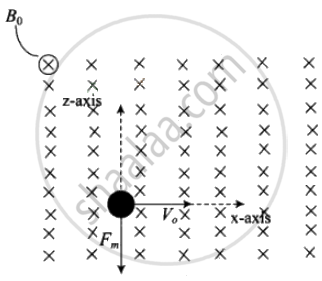Advertisements
Advertisements
प्रश्न
An electron is moving with an initial velocity `v = v_0hati` and is in a magnetic field `B = B_0hatj`. Then it’s de Broglie wavelength ______.
पर्याय
remains constant.
increases with time.
decreases with time.
increases and decreases periodically.
उत्तर
An electron is moving with an initial velocity `v = v_0hati` and is in a magnetic field `B = B_0hatj`. Then it’s de Broglie wavelength remains constant.
Explanation:
If a particle is carrying a positive charge q and moving with a velocity v and enters a magnetic field 5 then it experiences a force F which is given by the expression
F = q(v × B) = $ F = qvB sin θ. As this force is perpendicular to v and B, so the magnitude of v will not change, i.e. momentum (p = mv) will remain constant in magnitude.
According to the problem, `vecv = v_0i` and `vecB = B_0j`
Magnetic force on moving electron = `-e[v_0i xx B_0j] ⇒ - ev_0B_0k`

As this force is perpendicular to `vecv` and `vecB`, so the magnitude of v will not change, i.e. momentum (p = mv) will remain constant in magnitude. Hence, de-Broglie wavelength `lambda = h/(mv)` remains constant.
APPEARS IN
संबंधित प्रश्न
Calculate the momentum of the electrons accelerated through a potential difference of 56 V.
What is the
(a) momentum,
(b) speed, and
(c) de Broglie wavelength of an electron with kinetic energy of 120 eV.
The wavelength of light from the spectral emission line of sodium is 589 nm. Find the kinetic energy at which
(a) an electron, and
(b) a neutron, would have the same de Broglie wavelength.
Find the de Broglie wavelength of a neutron, in thermal equilibrium with matter, having an average kinetic energy of `(3/2)` kT at 300 K.
Show that the wavelength of electromagnetic radiation is equal to the de Broglie wavelength of its quantum (photon).
Find the typical de Broglie wavelength associated with a He atom in helium gas at room temperature (27°C) and 1 atm pressure, and compare it with the mean separation between two atoms under these conditions.
The de Broglie wavelength of a photon is twice the de Broglie wavelength of an electron. The speed of the electron is `v_e = c/100`. Then ______.
- `E_e/E_p = 10^-4`
- `E_e/E_p = 10^-2`
- `p_e/(m_ec) = 10^-2`
- `p_e/(m_ec) = 10^-4`
A proton and an α-particle are accelerated, using the same potential difference. How are the de-Broglie wavelengths λp and λa related to each other?
In a Frank-Hertz experiment, an electron of energy 5.6 eV passes through mercury vapour and emerges with an energy 0.7 eV. The minimum wavelength of photons emitted by mercury atoms is close to ______.
How will the de-Broglie wavelength associated with an electron be affected when the accelerating potential is increased? Justify your answer.
